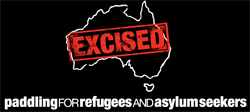
Thanks to Jean Fenton (NAILSMA), Lorna and Lisa (Amnesty International), and Nic Borgese and Waimei Lee (Melaleuca Refugee Centre) for organising the stall and sausage sizzle at Nightcliff Markets. Haven’t seen any money from you guys, but I’m sure it is about to hit the account.
Spent days at Jean’s place trying to get on top of this project of ours…..so much to do, but so little time. Although there was enough time to have some fascinating conversations with Jean, including about the failure of the green movement to engage and consult properly with traditional owners regarding issues concerning conservation and local, appropriate economic enterprises.
On the Wednesday, we paddled from Gunn Point to Darwin. Simon and Jean risked life and limb to get the kayaks to water, nearly rolling the car. We did an interview with Darwin ABC and then another with the Sports Factor (abc.net.au/rn/sportsfactor/stories/2007/2026772.htm) as we paddled between the mainland and Melville Island.

In November 2003, fourteen Turkish Kurds were detected on a boat, the Minasa Bone, at Melville Island near Darwin. After towing the boat 20 kilometres from the island, the government eventually turned them back to Indonesia, claiming that they had not even applied for asylum. This claim later turned out to be false. The government also claimed that it did not matter whether or not they had applied for asylum; Melville Island was excised and because of this, the Kurds were offshore entry persons who could not apply for a visa in Australia. As it happened, the gazetting of the excision of Melville (and Bathurst Island which, together form the Tiwi Islands) occurred after the Kurds had arrived, but because regulations take force from the midnight of the day they are gazetted, Melville Island was effectively excised before the asylum seekers had arrived there. The regulations were subsequently overturned by the Senate, but by then, they had done what they were designed to do – exclude the asylum seekers from being able to claim protection in Australia. The government vowed to find new ways of excising islands from the migration zone.
It is difficult not to view the excision of Melville Island in late 2003 as an entirely cynical act on the part of the government. It turned out that the Kurds’ applications for protection were rejected by the United Nations High Commissioner in Indonesia. Several people in Australia were reportedly linked with the group’s attempt to enter Australia without permission.
In Darwin we lost a big contingent of the EXCISED crew. Richard, Dot, Issie, Leo, Owen, Nadine, Tenzin and Annie all flew south. Thanks to you all for being part of the journey!









 It was not far from here that in July 2003 a boat called the Hao Kiet, with fifty-three Vietnamese passengers on board, was intercepted. It was initially assumed that the boat had not made it into Australia’s migration zone and that its passengers were therefore ineligible to apply for protection visas here. However, it was later revealed, as the passengers were being sent to Christmas Island – an excised offshore place – that they had indeed reached the migration zone, defined as the low water mark when the tide is out, or a port area. The Hoa Kiet had entered Port Hedland’s port’s limits – which extend 10 nautical miles out to sea. Immigration minister Ruddock was clearly annoyed at the prospect that the asylum seekers would now have access to the established checks and balances of Australia’s refugee protection determination system. For Ruddock, these were ‘complex, time-consuming and expensive arrangements.’ Notwithstanding the change in the legal situation, the government insisted that the group should continue to be removed to Christmas Island as a show that asylum seekers would not be allowed to make it to the Australian mainland. The Hoa Kiet passengers, when assessed by immigration department officials, were denied protection as refugees. However, when they appealed these negative decisions – which they were entitled to do because they had escaped the excised zone – the entire group was found to be genuine refugees after all. Most had been detained for more than two years.
It was not far from here that in July 2003 a boat called the Hao Kiet, with fifty-three Vietnamese passengers on board, was intercepted. It was initially assumed that the boat had not made it into Australia’s migration zone and that its passengers were therefore ineligible to apply for protection visas here. However, it was later revealed, as the passengers were being sent to Christmas Island – an excised offshore place – that they had indeed reached the migration zone, defined as the low water mark when the tide is out, or a port area. The Hoa Kiet had entered Port Hedland’s port’s limits – which extend 10 nautical miles out to sea. Immigration minister Ruddock was clearly annoyed at the prospect that the asylum seekers would now have access to the established checks and balances of Australia’s refugee protection determination system. For Ruddock, these were ‘complex, time-consuming and expensive arrangements.’ Notwithstanding the change in the legal situation, the government insisted that the group should continue to be removed to Christmas Island as a show that asylum seekers would not be allowed to make it to the Australian mainland. The Hoa Kiet passengers, when assessed by immigration department officials, were denied protection as refugees. However, when they appealed these negative decisions – which they were entitled to do because they had escaped the excised zone – the entire group was found to be genuine refugees after all. Most had been detained for more than two years.








